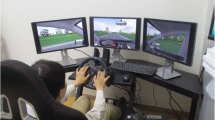Abstract
Purpose
Reduced driving reaction time (DRT) has already been studied in context with lumbar disc surgeries. Data on whether cervical spine pathologies impair driving abilities are still lacking. In addition, no return-to-driving recommendations after anterior cervical fusion procedures have been published. Therefore, we assessed DRT before and after anterior cervical discectomy and fusion.
Methods
We performed a prospective study with 12 patients (mean age 47.2 years; female 7, male 5). DRT as well as arm and neck pain were evaluated before surgery, on the day before discharge from hospital and at the 4–6-week follow-up examinations. 31 healthy subjects were tested for DRT as a control group.
Results
All patients showed significant improvement in DRT in the longitudinal course (p < 0.05). DRT was 601 ms (median, IQR: 63) before surgery, which was reduced to 580 ms (median, IQR: 112) on the day before discharge from hospital and to 532 ms (median, IQR: 48) at follow-up examination. Control subjects had a driving reaction time of 487 ms (median, IQR: 116), which differed significantly from that of patients at all three testing times (p < 0.05). VAS for arm and neck pain showed significant improvement (p < 0.05).
Conclusion
The present results show a positive effect of anterior cervical discectomy and fusion on driving safety. Based on our data we state that it appears to be safe to resume driving after discharge from hospital. However, patients scheduled to undergo anterior cervical discectomy and fusion should be informed about increased DRT as compared to healthy individuals.


Similar content being viewed by others
References
Al-khayer A, Schueler A, Kruszewski G, Armstrong G (1976) Grevitt MP (2008) Driver reaction time before and after treatment for lumbar radiculopathy. Spine Phila Pa 33(15):1696–1700. doi:10.1097/BRS.0b013e31817b5bb7
Bhadra AK, Raman AS, Casey AT, Crawford RJ (2009) Single-level cervical radiculopathy: clinical outcome and cost-effectiveness of four techniques of anterior cervical discectomy and fusion and disc arthroplasty. Eur Spine J 18(2):232–237. doi:10.1007/s00586-008-0866-8
Thaler M, Lechner R, Foedinger B, Haid C, Kavakebi P, Galiano K, Obwegeser A (2012) Driving reaction time before and after surgery for lumbar disc herniation in patients with radiculopathy. Eur Spine J 21(11):2259–2264. doi:10.1007/s00586-012-2378-9
Stokes M, Young A (1984) The contribution of reflex inhibition to arthrogenous muscle weakness. Clin Sci (Lond) 67(1):7–14
Liebensteiner MC, Birkfellner F, Thaler M, Haid C, Bach C (1976) Krismer M (2010) Driving reaction time before and after primary fusion of the lumbar spine. Spine Phila Pa 35(3):330–335. doi:10.1097/BRS.0b013e3181b8e11a
Ganz SB, Levin AZ, Peterson MG, Ranawat CS (2003) Improvement in driving reaction time after total hip arthroplasty. Clin Orthop Relat Res 413:192–200. doi:10.1097/01.blo.0000072468.32680.ff
Liebensteiner MC, Kern M, Haid C, Kobel C, Niederseer D, Krismer M (2010) Brake response time before and after total knee arthroplasty: a prospective cohort study. BMC Musculoskelet Disord 11:267. doi:10.1186/1471-2474-11-267
MacDonald W, Owen JW (1988) The effect of total hip replacement on driving reactions. J Bone Joint Surg Br 70(2):202–205
Marques CJ, Barreiros J, Cabri J, Carita AI, Friesecke C, Loehr JF (2008) Does the brake response time of the right leg change after left total knee arthroplasty? A prospective study. Knee 15(4):295–298. doi:10.1016/j.knee.2008.02.008
Spalding TJ, Kiss J, Kyberd P, Turner-Smith A, Simpson AH (1994) Driver reaction times after total knee replacement. J Bone Joint Surg Br 76(5):754–756
Gotlin RS, Sherman AL, Sierra N, Kelly M, Scott WN (2000) Measurement of brake response time after right anterior cruciate ligament reconstruction. Arthroscopy 16(2):151–155
Gotlin RS, Sherman AL, Sierra N, Kelly MA, Pappas Z, Scott WN (2000) Measurement of brake response time after right anterior cruciate ligament reconstruction. Arch Phys Med Rehabil 81(2):201–204
Scott PA, Candler PD, Li JC (1996) Stature and seat position as factors affecting fractionated response time in motor vehicle drivers. Appl Ergon 27(6):411–416
Sabatowski R (2008) Driving ability under opioids: current assessment of published studies. Dtsch Med Wochenschr 133(Suppl 2):S25–S28. doi:10.1055/s-2008-1081067
Byas-Smith MG, Chapman SL, Reed B, Cotsonis G (2005) The effect of opioids on driving and psychomotor performance in patients with chronic pain. Clin J Pain 21(4):345–352
Wilhelmi BG, Cohen SP (2012) A framework for driving under the influence of drugs policy for the opioid using driver. Pain physician 15(3):ES215–ES230
Sjogren P, Thomsen AB, Olsen AK (2000) Impaired neuropsychological performance in chronic nonmalignant pain patients receiving long-term oral opioid therapy. J Pain Symptom Manage 19(2):100–108
Veldhuijzen DS, van Wijck AJ, Wille F, Verster JC, Kenemans JL, Kalkman CJ, Olivier B, Volkerts ER (2006) Effect of chronic nonmalignant pain on highway driving performance. Pain 122(1–2):28–35. doi:10.1016/j.pain.2005.12.019
Hart RP, Martelli MF, Zasler ND (2000) Chronic pain and neuropsychological functioning. Neuropsychol Rev 10(3):131–149
Sjogren P, Christrup LL, Petersen MA, Hojsted J (2005) Neuropsychological assessment of chronic non-malignant pain patients treated in a multidisciplinary pain centre. Eur J Pain 9(4):453–462. doi:10.1016/j.ejpain.2004.10.005
Nunez VA, Giddins GE (2004) ‘Doctor, when can I drive?’: an update on the medico-legal aspects of driving following an injury or operation. Injury 35(9):888–890. doi:10.1016/j.injury.2003.11.009
Conflict of interest
None.
Author information
Authors and Affiliations
Corresponding author
Rights and permissions
About this article
Cite this article
Lechner, R., Thaler, M., Krismer, M. et al. Driving reaction time before and after anterior cervical fusion for disc herniation: a preliminary study. Eur Spine J 22, 1517–1521 (2013). https://doi.org/10.1007/s00586-013-2688-6
Received:
Revised:
Accepted:
Published:
Issue Date:
DOI: https://doi.org/10.1007/s00586-013-2688-6




